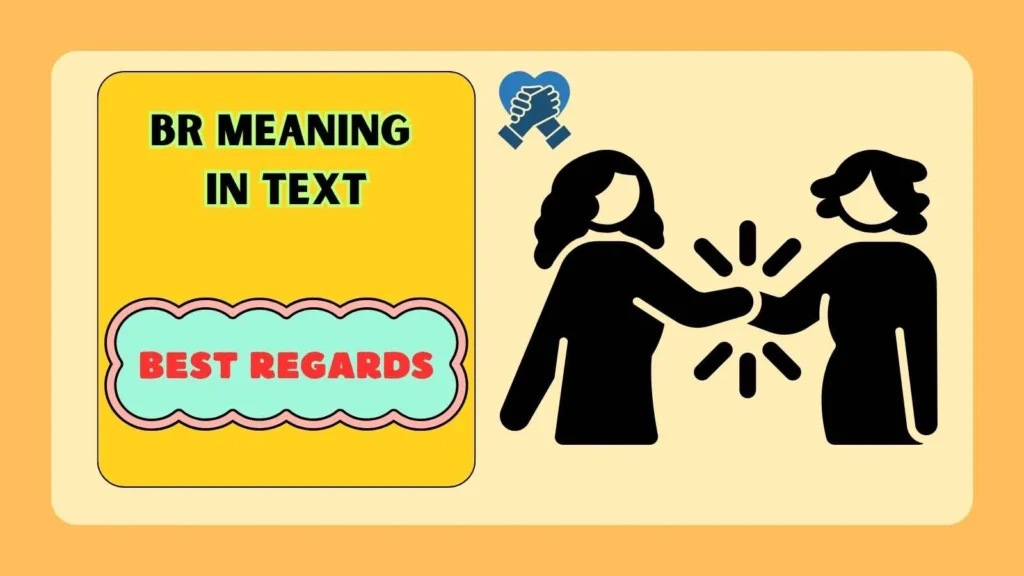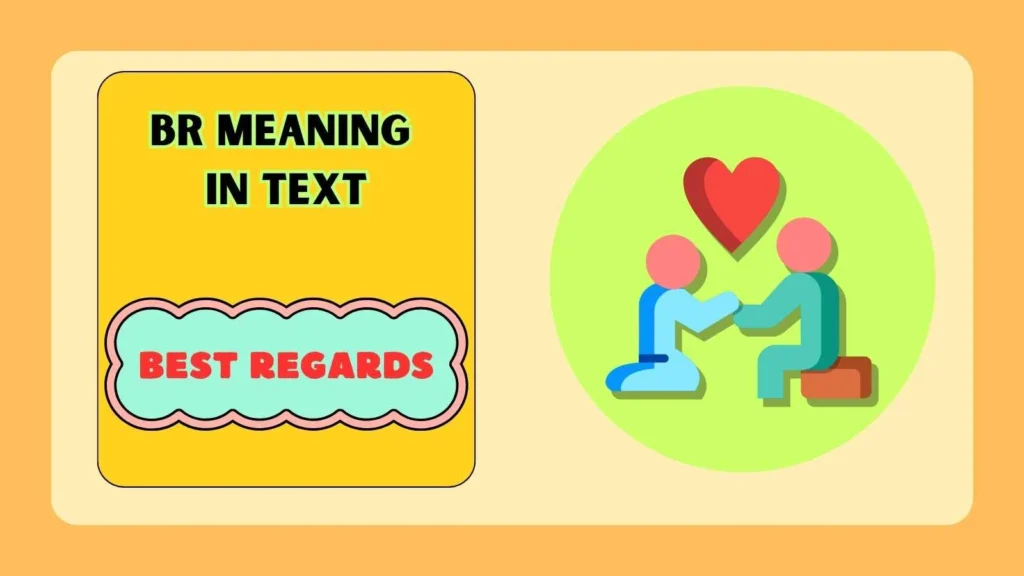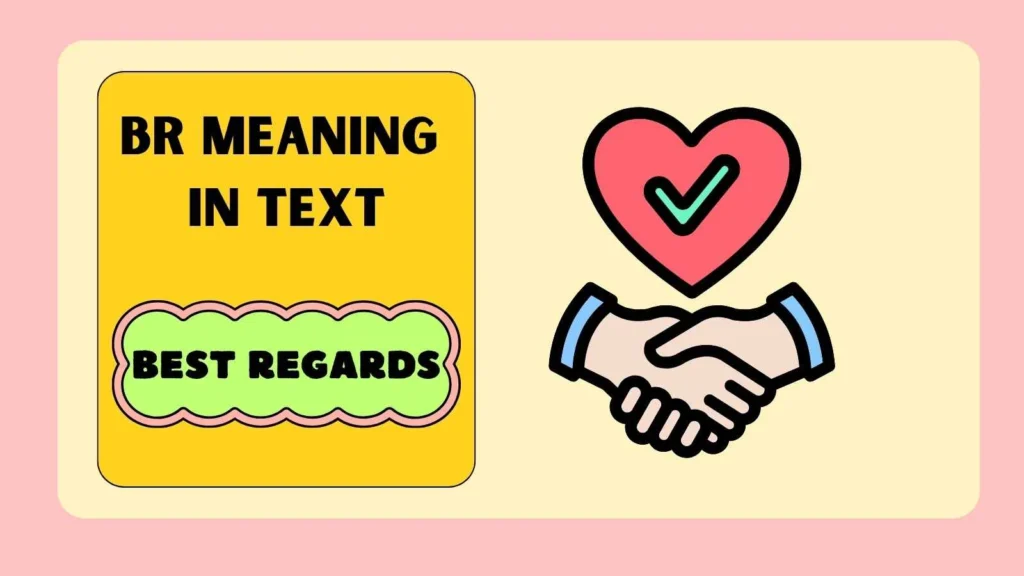Last updated on November 2nd, 2025 at 10:45 pm
Ever stumbled upon BR in a chat and wondered what it really means? You’re not alone! In today’s fast paced texting world, slang moves faster than memes. The BR meaning in text has gone viral, and everyone’s eager to know what this secret code stands for.
Whether you’ve seen it on social apps, in group messages, or during casual chats, this is your ultimate guide to decode it.
Get ready as we break down this short yet mysterious term that’s got everyone talking. Let’s dive deep and uncover the true meaning behind BR that’s shaping digital communication.
Definition & Meaning
The abbreviation BR most commonly stands for “Best Regards” in text, chat, and emails. It’s a polite way to end a message, especially in professional or semi-formal communication. However, in casual texting, BR can also mean “Be Right” (as in “Be right back” or “Be right there”), depending on the tone and platform.
For instance:
- In business communication: “Thanks for your time. BR, Alex.”
- In texting: “Hold on, BR there.”
This abbreviation shows how adaptable language has become in digital spaces. The meaning of BR in text shifts based on intent—formal in one setting and casual in another. It represents the growing blend of professionalism and informality in modern communication.
Background & History
The usage of BR originated in early email etiquette during the late 1990s and early 2000s. Professionals began using “Best Regards” as a formal sign-off to show respect or goodwill. As email culture merged with texting and instant messaging, abbreviations became a norm to save time and space.
Over time, younger users on MSN, Yahoo Messenger, and early SMS chats started shortening common phrases, giving rise to compact expressions like BR, TTYL (Talk To You Later), and BRB (Be Right Back). Interestingly, the latter phrase often caused confusion—many thought BR was just a shortened version of BRB.
Today, BR continues to evolve as both a formal closing phrase and a casual response, depending on context. It reflects how digital communication keeps redefining politeness and efficiency in online conversations.
Usage in Various Contexts
The meaning of BR in text changes depending on where and how it’s used.
1. In Professional Emails
Here, BR is a short version of “Best Regards”, a courteous way to end an email. It’s common in workplaces, especially among coworkers or clients who communicate frequently.
Example:
“Looking forward to your reply. BR, Maria.”
2. In Casual Texting
Among friends, BR can mean “Be Right”—a shorthand way to say you’ll return soon.
Example:
“BR back, just grabbing a drink.”
3. In Gaming or Chat Rooms
Gamers often use BR as quick slang meaning “Be Right”, saving time mid-game.
4. In Online Forums
Some users use BR as a signature or sign-off symbolizing respect, friendliness, or closure.
This flexibility makes BR a multifunctional abbreviation—polite in business, casual in chat, and quick in gaming.
Common Misconceptions & Clarifications
Many people misunderstand BR meaning in text, often mixing it up with BRB (Be Right Back) or BRUH.
Here are some common misconceptions:
- Myth 1: BR always means “Be Right Back.”
Fact: That’s actually BRB. BR can stand for “Be Right” or “Best Regards.” - Myth 2: BR is only for formal messages.
Fact: It’s used informally too, especially among friends. - Myth 3: BR is outdated.
Fact: It’s still widely used, especially in workplaces and social media DMs.
Clarifying these differences ensures your message tone fits the conversation type—whether you’re texting a friend or emailing your boss.
Similar Terms & Alternatives
If BR feels too short or formal, here are similar expressions you might encounter:
- BRB – Be Right Back
- TTYL – Talk To You Later
- CU – See You
- Kind Regards (KR) – Polite sign-off for professional emails
- Regards / Cheers – Friendly alternatives for ending a message
Each has its own tone and level of formality. Choosing the right one depends on who you’re messaging and how professional the conversation is.
How to Respond to This Term
Your response to BR depends on the context:
- If it’s professional: Simply reply politely or sign off in kind (e.g., “Thanks, BR.”).
- If it’s casual: You can just continue the chat or reply “ok,” “np,” or “cool.”
- If unsure: Observe the tone of the conversation—formal or friendly—and match it.
Being context-aware ensures you respond naturally without sounding stiff or overly casual.
Regional or Cultural Differences
While BR is used globally, its interpretation can vary:
- In North America and Europe: Commonly means “Best Regards.”
- In Asia: Sometimes shortened from “Be Right” or used informally in gaming.
- In Latin America: Some use “BR” as slang for “Brazilian”, especially in online communities.
These cultural nuances highlight why understanding your audience is key before using abbreviations.
Comparison with Similar Terms
Let’s compare BR with other common chat endings:
| Term | Meaning | Tone | Usage |
|---|---|---|---|
| BR | Best Regards / Be Right | Neutral | Professional & casual |
| BRB | Be Right Back | Casual | Online chats |
| KR | Kind Regards | Formal | Work emails |
| Cheers | Thanks / Goodbye | Friendly | British / casual |
| TY | Thank You | Casual | Texting |
This table shows how BR balances between politeness and simplicity, making it adaptable to nearly any context.
Usage in Online Communities & Dating Apps
In online communities, BR is often used as a short, polite sign-off—especially on platforms like Reddit or Discord. For example, someone might end a helpful post with “BR, Sam.”
In dating apps, however, it’s less common and may confuse users unfamiliar with email-style endings. Still, a few people might use it casually to sound friendly or respectful after a chat:
“Nice chatting with you! BR 😊”
So while BR meaning in text is widely understood, it’s best to avoid it in flirtatious or highly casual settings where it might seem overly formal.
Hidden or Offensive Meanings
Unlike some acronyms, BR generally doesn’t carry offensive meanings. However, in specific slang or gaming communities, it can occasionally be used as shorthand for something unrelated, such as “Battle Royale” (referring to game modes like Fortnite or PUBG).
Always consider context before interpreting BR—it’s usually harmless, but meaning can shift in niche spaces.
Suitability for Professional Communication
In the workplace, BR is perfectly acceptable for internal communication or quick replies between colleagues. It saves time while maintaining a tone of respect. However, when emailing clients or new contacts, it’s better to use the full form “Best Regards” to appear more professional and polished.
Example:
✅ Appropriate: “Thanks for your input. BR, Taylor.”
⚠️ Better for formal tone: “Thank you for your time. Best Regards, Taylor.”
Professionalism often lies in detail—so choose the form that best fits your audience.
💬 BR Meaning in Chat from a Girl

- 💖 Usually, BR from a girl means “Be Right” — short for Be Right Back (BRB).
- 😊 Sometimes it shows care or reassurance, like “BR, don’t go anywhere!”
- 💬 Girls use BR to pause a chat politely without ending it.
- 💫 It often signals she’s multitasking but still interested in continuing the talk.
- 📱 When paired with emojis, BR can feel friendly or flirty, depending on tone.
- 💭 In casual texting, it’s a soft, social cue rather than a strict goodbye.
- 🔥 Some girls use it playfully to keep the chat energy alive.
- 💌 If followed by “soon” or “babe,” it may carry a romantic undertone.
- 🌸 In group chats, BR helps girls stay included even when briefly away.
- 💬 Overall, BR from a girl means “Hold on — I’ll be right back ❤️.”
💬 BR Meaning in Text from a Guy
- 💪 When a guy texts BR, it often means “Be Right Back.”
- ⚡ However, tone and timing can change its meaning quickly.
- 📲 In gaming or tech circles, BR might stand for “Battle Royale.”
- 😎 Sometimes, it’s just casual shorthand showing he’s still active online.
- 🧠 If he says BR mid-conversation, it’s usually polite and brief.
- 💬 Yet, in flirty chats, BR can mean “Be Ready” — hinting at future plans.
- 🤔 A guy might use it to pause without sounding uninterested.
- 🔥 When combined with humor or emojis, it keeps the vibe light.
- 👀 Some guys drop BR just to check your reaction or maintain tension.
- 💭 Context always matters — but mostly, BR = “Be Right Back, talk soon!”
❤️ BR Meaning in Relationship

- 💞 In relationships, BR often means “Be Right Back” — a short pause, not distance.
- 💬 Couples use it to stay connected even during short breaks.
- 🫶 Sometimes, it’s playful — “BR, miss me yet?” 😉
- 🌹 When paired with affectionate emojis, it shows comfort and trust.
- 💭 On the other hand, repeated BR without follow-up might signal distraction.
- ⚡ In romantic texting, tone decides if BR feels cute or cold.
- 🧠 Some partners use BR as code for quick personal time.
- 💬 It can also mean “Be Ready” — hinting at something exciting ahead.
- 💕 Frequent BR messages reflect openness and casual communication.
- 🌈 Ultimately, BR in a relationship means “We’re good — just a quick pause.”
FAQs
What does BR mean in text?
It usually stands for Best Regards or Be Right, depending on context.
Is BR the same as BRB?
No, BRB means Be Right Back, while BR may mean Best Regards or Be Right.
Can I use BR in a formal email?
Yes, but Best Regards written in full is more polished.
Does BR have an offensive meaning?
No, BR is generally neutral and not offensive.
Is BR used in gaming?
Yes, gamers often use it to mean Be Right or Battle Royale.
Should I use BR in texting my crush?
Probably not—it can sound too formal or robotic in a flirty chat.
Conclusion
The abbreviation BR in text is a versatile expression bridging the gap between formal etiquette and casual simplicity. Whether it stands for Best Regards in a business email or Be Right in a chat, its meaning depends on context.
Understanding how, when, and where to use BR helps you sound both polite and modern, while avoiding confusion.
In the ever-evolving world of digital language, small abbreviations like BR continue to shape how we express tone, speed, and emotion online. So next time someone signs off with BR—you’ll know exactly what they mean.
